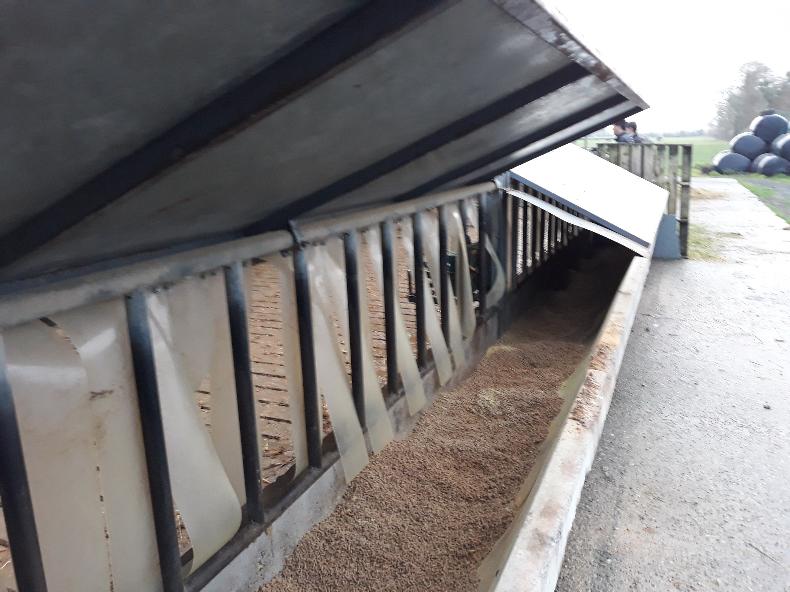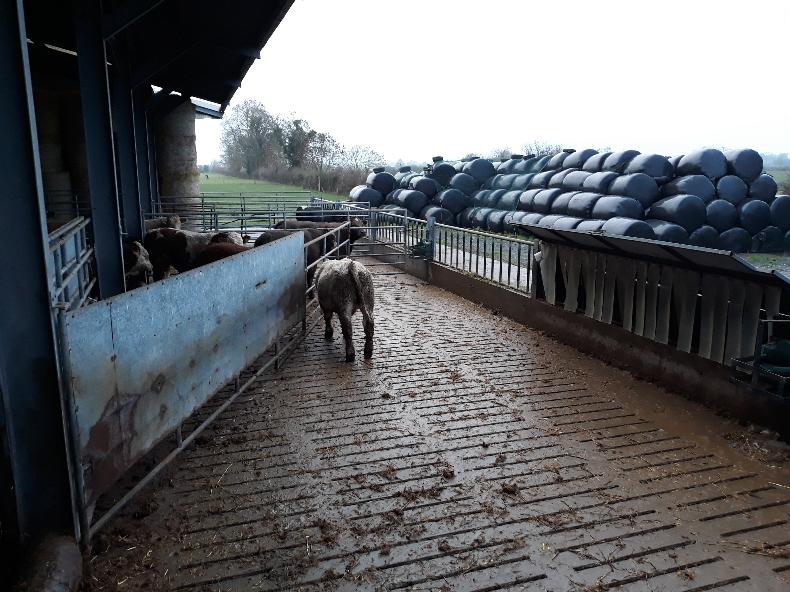The feature on this week’s buildings page is timely given the Focus on winter feed (pages 43 to 47). There have been a few queries from farmers of late regarding feeders which are suitable for feeding ad-lib concentrates to significant numbers of bulls. The feeders are required to be bird-proof and robust enough to withstand bulls.
In reviewing feeding systems seen during farm visits in recent years, one quickly comes to mind. This well-designed feeder was spotted during a visit to the farm of Noel and Joan Farrell who were awarded a Bord Bia Origin Green Sustainability award for their suckler-to-beef enterprise in Golden, Co Tipperary.
The shed where bulls were finished is impressive. There is a large lie-back area and animals had access to an unroofed slatted area at the front for feeding. Two of the pens set up to finish bulls had ad-lib concentrate feeders erected along the feeding barrier. Noel says the only downside with bulls is that the curtains may need to be replaced regularly.
Feeder design
The base of the feeder comprises standard concrete feed troughs with two sections joined to service each pen. The troughs were fitted tight to the feeding barrier, which shows a section of the feeder covering one pen. Heavy-duty transparent pvc curtains hanging from the top of the feed barrier prevent birds from entering the feeder.
The feeders are covered with a steel cover which was erected similar to a lean-to roof.

The cover sits on the concrete trough preventing rainfall from entering the trough while also giving it extra stability.
The overhang of the feeder prevents rain from blowing into the feeder from the front, while the bottom of the cover sits on the concrete trough. This serves to prevent rainfall from entering the trough and also gives the cover its stability.
The steel cover is constructed with box iron welded together while the flat sheet of steel is fastened with rivets.
The most impressive part of the design is how this cover is fastened to the feeding barrier.
The top of the feeding barrier acts as a pivot that allows the cover to swing in excess of 180 degrees. The joining of the cover to the barrier is midway in height of the cover which means it is finely balanced and swings with ease.

The top of the feeding barrier acts as a pivot for the cover to open and close.
When fully open, the cover swings down parallel to the feeding barrier and prevents animals from accessing the feeder. This allows the feeder to be filled easily without interference from bulls while it also allows feeders to be regularly cleaned, if required. This is essential from a management perspective and the fact it can be carried out in a safe manner should not be underestimated.
Low-cost option: The design of the feeder is well thought-out but straightforward to construct. It can be constructed by farmers who are accustomed to welding and simple steelworks. In such a case, the most significant cost of the development is materials. The design on the Farrell farm works excellently in an outdoor setting but a similar design will also work indoors where birds are an issue and greater protection for feed is required.
The feature on this week’s buildings page is timely given the Focus on winter feed (pages 43 to 47). There have been a few queries from farmers of late regarding feeders which are suitable for feeding ad-lib concentrates to significant numbers of bulls. The feeders are required to be bird-proof and robust enough to withstand bulls.
In reviewing feeding systems seen during farm visits in recent years, one quickly comes to mind. This well-designed feeder was spotted during a visit to the farm of Noel and Joan Farrell who were awarded a Bord Bia Origin Green Sustainability award for their suckler-to-beef enterprise in Golden, Co Tipperary.
The shed where bulls were finished is impressive. There is a large lie-back area and animals had access to an unroofed slatted area at the front for feeding. Two of the pens set up to finish bulls had ad-lib concentrate feeders erected along the feeding barrier. Noel says the only downside with bulls is that the curtains may need to be replaced regularly.
Feeder design
The base of the feeder comprises standard concrete feed troughs with two sections joined to service each pen. The troughs were fitted tight to the feeding barrier, which shows a section of the feeder covering one pen. Heavy-duty transparent pvc curtains hanging from the top of the feed barrier prevent birds from entering the feeder.
The feeders are covered with a steel cover which was erected similar to a lean-to roof.

The cover sits on the concrete trough preventing rainfall from entering the trough while also giving it extra stability.
The overhang of the feeder prevents rain from blowing into the feeder from the front, while the bottom of the cover sits on the concrete trough. This serves to prevent rainfall from entering the trough and also gives the cover its stability.
The steel cover is constructed with box iron welded together while the flat sheet of steel is fastened with rivets.
The most impressive part of the design is how this cover is fastened to the feeding barrier.
The top of the feeding barrier acts as a pivot that allows the cover to swing in excess of 180 degrees. The joining of the cover to the barrier is midway in height of the cover which means it is finely balanced and swings with ease.

The top of the feeding barrier acts as a pivot for the cover to open and close.
When fully open, the cover swings down parallel to the feeding barrier and prevents animals from accessing the feeder. This allows the feeder to be filled easily without interference from bulls while it also allows feeders to be regularly cleaned, if required. This is essential from a management perspective and the fact it can be carried out in a safe manner should not be underestimated.
Low-cost option: The design of the feeder is well thought-out but straightforward to construct. It can be constructed by farmers who are accustomed to welding and simple steelworks. In such a case, the most significant cost of the development is materials. The design on the Farrell farm works excellently in an outdoor setting but a similar design will also work indoors where birds are an issue and greater protection for feed is required.








 This is a subscriber-only article
This is a subscriber-only article










SHARING OPTIONS: